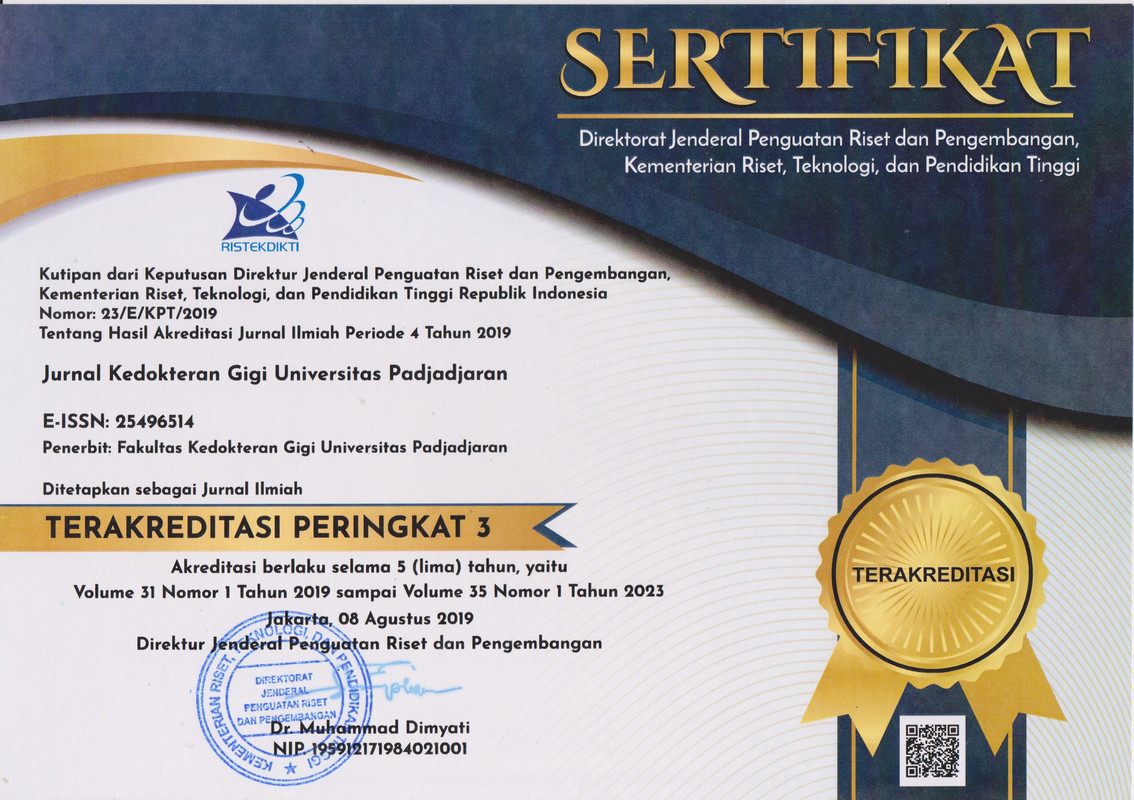Dental fear anak dengan gangguan spektrum autisme terhadap perawatan gigi
Dental fear in children with autism spectrum disordersAbstract
Pendahuluan: Dental fear (DF) adalah reaksi emosional individu terhadap satu atau lebih rangsangan spesifik (bor gigi, jarum suntik) yang dianggap menakutkan selama perawatan gigi berlangsung atau suasana tempat praktek gigi secara umum. DF yang dialami anak dengan Gangguan Spektrum Autisme (GSA) dapat menimbulkan perilaku tidak kooperatif pada anak antara lain menangis, berteriak, menolak atau menghindari perawatan gigi. Hal tersebut dapat menyebabkan perawatan gigi menjadi terhambat, tertunda, bahkan tidak jadi dilakukan yang berakibat pada peningkatan resiko masalah gigi dan mulut. Tujuan penelitian adalah mengetahui DF anak GSA terhadap perawatan gigi di Yayasan Biruku Kota Bandung. Metode: Jenis penelitian deskriptif dengan metode cross-sectional. Sampel penelitian adalah anak GSA yang pernah menerima perawatan gigi sebelumnya dan didampingi oleh orang tua selama menerima perawatan dengan jumlah 19 anak diperoleh menggunakan teknik total sampling. Pengambilan data dilakukan menggunakan kuesioner Children Fear Survey Schedule-Dental Subscale (CFSS-DS) diisi oleh orang tua anak. Hasil: Rerata jumlah skor DF responden penelitian adalah 38,4. Tingkat DF tinggi ditemukan pada 7 anak (36,84%), DF sedang pada 5 anak (26,32%), DF rendah pada 7 anak (36,84%). Stimulus DF yang paling ditakuti oleh responden adalah ketika giginya dibor oleh dokter gigi (9,19%) sedangkan yang tidak ditakuti adalah ketika melihat orang berpakaian putih (4,12%). Simpulan: DF anak GSA terhadap perawatan gigi di Yayasan Biruku Kota Bandung berada dalam kategori sedang.
Kata kunci: Anak gangguan spektrum autism; dental fear; perawatan gigi; children fear survey schedule-dental subscale
ABSTRACT
Introduction: Dental fear (DF) is an individual's emotional reaction to one or more specific stimuli (dental drill, syringe) that is considered scary during dental treatment or the general atmosphere of the dental practice. DF experienced by children with Autism Spectrum Disorder (ASD) can cause uncooperative behaviour in children, including crying, screaming, refusing or avoiding dental treatment. This can cause dental care to be hampered, delayed, or even not done, resulting in an increased risk of dental and oral problems. This study aimed to determine the DF of ASD children on dental care at the Biruku Foundation, Bandung City. Methods: This type of research was descriptive with a cross-sectional method. The study sample was ACS children who had received previous dental treatment and were accompanied by their parents while receiving treatment, with a total of 19 children obtained using a total sampling technique. Data were collected using the Children Fear Survey Schedule-Dental Subscale (CFSS-DS) questionnaire filled out by the child's parents. Results: The mean total DF score of the research respondents was 38.4. High DF level was found in 7 children (36.84%), moderate DF in 5 children (26.32%), low DF in 7 children (36.84%). The most feared DF stimulus by the respondents was when their teeth were drilled by a dentist (9.19%), while what was not feared was when they saw people wearing white clothes (4.12%). Conclusion: The DF of GSA children towards dental care at the Biruku Foundation, Bandung City, is moderate.
Keywords: Autism spectrum disorder; children; dental fear; dental treatment; Children Fear Survey Schedule Dental Subscale
Keywords
Full Text:
PDFReferences
DAFTAR PUSTAKA
Susanto A, Sopiatin S, Sasmita IS. Oral health and gingival status of children with autism in Bandung City , Indonesia. Int J Adv Sci Technol. 2020;29(6):4025–30.
Faras H, Al Ateeqi N, Tidmarsh L. Autism spectrum disorders. Ann Saudi Med. 2011 Jul;30(4):295–300. DOI: 10.4103/0256- 4947.65261
Robson B. Autism spectrum disorder: A review of the current understanding of pathophysiology and complementary therapies in children. Aust J Herb Med. 2013;25(3).
Oktaviana W, Amir Y, Indriati G. Identifikasi tingkat pengetahuan ibu tentang diet casein free dan gluten free pada anak autis. JOM FKp. 2018;5(2):1–6.
Putri DMB. Kajian interior pada ruang kelas paud autis di klinik terapi our dreams bandung. e-Proceeding Art Des. 2015;2(2):856–64.
Stein Duker LI, Henwood BF, Bluthenthal RN, Juhlin E, Polido JC, Cermak SA. Parents’ perceptions of dental care challenges in male children with autism spectrum disorder: An initial qualitative exploration. Res Autism Spectr Disord. 2017;39(323):63–72. DOI: 10.1016/j. rasd.2017.03.002
Logrieco MGM, Ciuffreda GN, Sinjari B, Spinelli M, Rossi R, D’Addazio G, et al. What happens at a dental surgery when the patient is a child with autism spectrum disorder? an Italian study. J Autism Dev Disord. 2020;51(6):1939– 52. DOI: 10.1007/s10803-020-04684-0
Elfarisi RN, Susilawati S, Suwargiani AA. Kesehatan gigi dan mulut terkait kualitas hidup anak usia 4-5 tahun di Desa Cilayung. J Kedokt Gigi Univ Padjadjaran. 2018;30(2):85– 94. DOI:10.24198/jkg.v30i3.18509
Stein LI, Polido JC, Mailloux Z, Coleman GG, Cermak SA. Oral care and sensory sensitivities in children with autism spectrum disorders. Spec Care Dent. 2011;31(3):102– 10. DOI: 10.1111/j.17544505.2011.00187.x
Serra-Negra J, Paiva S, Oliveira M, Ferreira F, Freire-Maia F, Pordeus I. Self-reported dental fear among dental students and their patients. Int J Environ Res Public Heal. 2012;9:44–54.
Campbell C. Dental Fear and Anxiety in Pediatric Patients: Practical Strategies to Help Children Cope. Glasgow: Springer; 2017. 4–10 p.
Veriza E, Boy H. Perilaku pemeliharaan kesehatan gigi dan mulut pada anak autisme. Faletehan Heal J. 2018;5(2):55–60. DOI: 10.33746/fhj.v5i2.9
Suzy A, Amriwijaya J, Fitriana E. Trans- adapted, reliability, and validity of children fear survey schedule-dental subscale in Bahasa Indonesia. Dent J (Majalah Kedokt Gigi). 2015;48(1):1–6. DOI:10.20473/j.djmkg.v48. i1.p1-6
Raj S, Aradhya K, Nagakishore V. Evaluation of dental fear in children during dental visit using children’s fear survey schedule-dental subscale. Int J Clin Pediatr Dent. 2013;6(1):12– 5. DOI: 10.5005/jp-journals-10005-1178
Yon MJY, Chen KJ, Gao SS, Duangthip D, Lo ECM, Chu CH. An Introduction to Assessing Dental Fear and Anxiety in Children. Healthcare. 2020 Apr 4;8(2):86.DOI: 10.3390/ healthcare8020086
Stein LI, Lane CJ, Williams ME, Dawson ME, Polido JC, Cermak SA. Physiological and behavioral stress and anxiety in children with autism spectrum disorders during routine oral care. Biomed Res Int. 2014;2014:1–10. DOI: 10.1155/2014/694876
Richman DM, Dotson WH, Rose CA, Thompson S, Abby L. Effects of age on the types and severity of excessive fear or the absence of fear in children and young adults with autism. J Ment Health Res Intellect Disabil. 2012;5(3–4):215–35.DOI:10.1080/19315864.2011.596614
Strang JF, Kenworthy L, Daniolos P, Case L, Wills MC, Wallace GL. Depression and anxiety symptoms in children with autism spectrum disorders without intellectual disability. Res Autism Spectr Disord. 2012;6(1):406–12. DOI: 10.1016/j.rasd.2011.06.015
Pekkan G, Kilicoglu A, Hatipoglu H. Relationship between dental anxiety, general anxiety level and depression in patients attending a university hospital dental clinic in turkey. Community Dent Health. 2011;28(2):149–53.
Yildirim TT, Dundar S, Bozoglan A, Karaman T, Dildes N, Kaya FA, et al. Is there a relation between dental anxiety, fear and general psychological status? PeerJ. 2017;2017(2):1– 11. DOI: 10.7717/peerj.2978
Chapman HR, Kirby-Turner N. Psychological intrusion - An overlooked aspect of dental fear. Front Psychol. 2018;9(1):1–19. DOI: 10.3389/ fpsyg.2018.00501
Sanger SE, Pangemanan DHC, Leman MA. Gambaran Kecemasan Anak Usia 6-12 Tahun terhadap Perawatan Gigi di SD Kristen Eben Haezar 2 Manado. e-GIGI. 2017 Jul 7;5(2):190– 6. DOI:10.35790/eg.5.2.2017.17394
Thirumuru A, Ditto Sharmin D. Dental management and behavioural modifications of children with autism spectrum disorders (ASD). EC Dent Sci. 2015;1(2):33–55.
Nugraheni SA. Menguak belantara autisme. Bul Psikol. 2012;20(1–2):9–17.
Weil TN, Bagramian RA, Inglehart MR. Treating patients with autism spectrum disorder-scda members’ attitudes and behavior. Spec Care Dent. 2011;31(1):8–17. DOI: 10.1111/j.17544505.2010.00173.x
Wu L, Gao X. Children’s dental fear and anxiety: Exploring family related factors. BMC Oral Health. 2018;18(1):1–10. DOI: 10.1186/ s12903-018-0553-z
McCarty R. The Fight-or-Flight Response: A Cornerstone of Stress Research. Stress: Concepts, Cognition, Emotion, and Behavior: Handbook of Stress. Nashville: Elsevier Inc.; 2016. 33–37 p.
Koch G, Poulsen S, Haubek D. Pediatric Dentistry a Clinical Approach. 3rd ed. West Sussex: John Wiley & Sons, Ltd; 2017. 57–59 p.
Krikken JB, Veerkamp JS. Child rearing styles, dental anxiety and disruptive behaviour; an exploratory study. Eur Arch Paediatr Dent. 2008;9 Suppl 1:23–8.
DOI: https://doi.org/10.24198/jkg.v33i3.34271
Refbacks
- There are currently no refbacks.
Copyright (c) 2021 Jurnal Kedokteran Gigi Universitas Padjadjaran
INDEXING & PARTNERSHIP

Jurnal Kedokteran Gigi Universitas Padjadjaran dilisensikan di bawah Creative Commons Attribution 4.0 International License






.png)

















